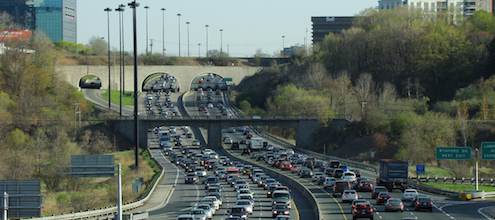
You think your daily battle with traffic is bad? Try driving a truck all day in the city
by Jonathan Arnold and Nancy Olewiler
People who commute by car love to share their epic battles with road congestion. But how would you feel if driving in congestion was a part of your job? Picture this: you’re a truck driver or a tradesperson, sitting in gridlock trying to get to your next shipment or worksite. You’re watching the minutes (or hours) go by, impatiently watching as pedestrians on the sidewalk pass your crawling vehicle. Alas, no matter what you do, or how many times you fruitlessly switch lanes, you’re helpless on the tarmac. This delay is costing you and your company money.
Road congestion gums up the economic and environmental works
For the average commuter, traffic results in longer waits, increased fuel consumption, and stress. The impacts to commercial vehicles, however, cut much deeper. Trucking is an integral part of our economy and affects us all on a personal level: 90% of the goods we consume on a daily basis are transported by truck at one point. Road congestion causes a range of impacts to the trucking industry, creating a domino effect on intermodal supply chains, particularly for high-value and time-sensitive goods, such as pharmaceuticals or perishable food. Businesses are forced to come up with coping mechanisms to deal with these delays, such as increasing fleet size (to help offset fewer trips being made), expanding delivery schedules to factor in delays, and stocking more inventory.
These delays have real economic costs. The U.S. Department of Transportation estimates that the trucking industry loses approximately $27 billion per year from the costs of lost time and extra fuel. Nike, for example, pays an added $4 million per week in the US to ensure they have enough inventory to deal with shipping delays. And these estimates are only looking at a fraction of the total costs to the entire supply chain.
Commercial vehicles also have a larger environmental footprint. Trucks emit higher levels of air pollutants and greenhouse gases than passenger vehicles, and are much noisier. These pollutants are magnified in stop-and-go traffic: gearing up, gearing down, and idling. The combination of trucks and cars during rush-hour increases air pollutants that have serious implications to human health—especially for infants and children. And considering one-third of Canadians live in areas near highways or major urban roads, many of us are exposed to these fumes and consequent health risks.
Whether you’re a city or rural dweller, congestion hits your pocketbook
The economic costs of congestion for commercial goods movement don’t just fall on urbanites. Rural communities are also affected by slower moving trucks, even if road congestion isn’t a problem in their hometown. The delays created at freight hubs in Canadian cities due to traffic are passed onto goods being shipped to rural communities. Some of these costs are inevitably passed onto consumers in the form of higher prices, regardless of where one lives.
What’s the trucking answer?
How can we reduce the economic and environmental costs of road congestion, while still facilitating goods movement and fostering vibrant cities? The Ecofiscal Commission’s recent report recommends congestion pricing as part of a pragmatic answer. Congestion pricing is an ecofiscal policy that prices road-use or parking with the aim of reducing costly traffic congestion. In a nutshell, a congestion price encourages drivers who have more flexibility to travel at different times or to switch to public transit or carpooling; those with stricter time schedules, and who place a higher value on their trip, can pay the congestion price and get a faster more reliable commute in return.
The potential gains for commercial goods movement are big. Truckers generally have less freedom in terms of where and when they travel, and place a high value on reliable and predictable delivery times. Congestion pricing can make trips more reliable, expand market opportunities, and can improve access to employment centres, educational opportunities, and goods and services. Providing the system is designed well, these economic benefits will be larger than the cost of tolls.
Commercial vehicles are on the front lines of traffic, 365 days a year, yet are often overlooked in discussions about congestion pricing. In order to better facilitate goods movement in our cities, allowing goods and services to move more freely, congestion pricing needs serious consideration. It’s high time we get trucks unstuck in traffic.




Comments are closed.